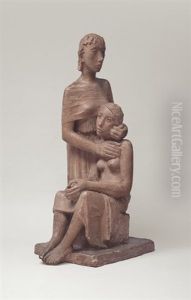Joachim Karsch Paintings
Joachim Karsch was a German sculptor born on May 15, 1897, in Glatz, a town then in the Prussian Province of Silesia (now Kłodzko, Poland). His work spans a critical period in German history, capturing the interwar period, the rise of National Socialism, and the aftermath of World War II. Karsch's artistic journey is marked by a dedication to the human form and the exploration of both traditional and modernist sculptural techniques.
Karsch's early life was shaped by his education in art, which began in the bustling cultural environment of Berlin, where he moved in 1914. His studies were interrupted by World War I, in which he served, and the experiences of war deeply influenced his artistic vision, imbuing his work with themes of human suffering and resilience. After the war, he continued his education at the Berlin University of the Arts, where he was exposed to a variety of artistic movements and ideologies.
The 1920s and 1930s were a period of significant artistic development for Karsch. He immersed himself in the Berlin art scene, which was a hub for avant-garde movements. His work from this period reflects a blend of realism and expressionism, with a strong emphasis on the emotional and psychological depth of his subjects. Karsch gained recognition for his portrait busts, which captured the individuality and inner life of his sitters, including notable figures of his time.
However, Karsch's career was not without challenges. The rise of the Nazi regime in Germany had a profound impact on the artistic community, and Karsch's work, which did not conform to the ideological demands of National Socialist aesthetics, faced increasing marginalization. Despite these difficulties, he continued to work, focusing on themes of human dignity and the enduring spirit of humanity.
After World War II, Karsch's work took on new significance in a devastated Germany. His sculptures from this period reflect a search for renewal and reconciliation, both in the individual and in the collective German identity. Karsch remained active in the art community, participating in exhibitions and taking on commissions that contributed to the cultural rebuilding of post-war Germany.
Joachim Karsch's death in Berlin on October 12, 1952, marked the end of a career that had navigated some of the most tumultuous periods in German history. His legacy is preserved in his sculptures, which continue to be celebrated for their technical mastery and profound humanity. Karsch's work remains a testament to the power of art to capture the complexities of the human condition and to endure through times of profound change.

